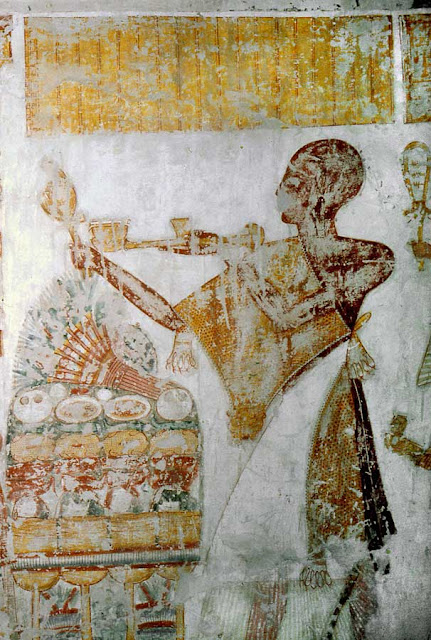
The great god of the dead, designated as "Osiris, who is at the head of the west, Wennefer" is placed in a very selective area, such that any incoming visitor coming into the tomb cannot miss it. Osiris is seated under a kiosk which is extremely colourful and contains large heavily decorated supporting columns (the left hand one is almost lost), in accordance with the strange taste of the Ramesside period. The roof of the kiosk is decorated with upright solar cobras, with a coving at the front. At the top of the column is also decorated with two cobras, adding more to the great many on the roof. The column is composed of a multiple of symbols. Between the columns is stretched a deep red cloth decorated with hexagons, which, at its upper edge is a large multicoloured floral motif. Osiris is seated on a richly decorated cubic throne, with a frieze of cobras surmounting a decorated facade of a palace. The god has green skin, the colour of vegetation, and carries his usual attributes: atef-crown, hooked beard, with a crook and flail in each hand. He is clothed in a golden shroud, which, without being exceptional, is not very common. A large usekh necklace spreads across his chest, as well as a pectoral, the details of which have disappeared.
Behind Osiris stands "Anubis, Lord of the Sacred Land" with a black head of the jackal, who places his hands on the god's shoulders in a sign of protection. The illegitimate son of Osiris and Nephthys (according to some legends), he was the one who created the first mummy, that of Osiris.
The Offerings, officiant and followers
In front of Osiris, in his kiosk, is a pile of offerings. To the right of this stands the officiant followed by five other people, two of which are portrayed smaller.
The offerings are piled up on the four high pedestals, with some items between them. Water from a libation spills from the table (left side) on which the offerings are piled. This is being caught by a Ba-bird which stands between the bottom of the column of the kiosk and the left-hand pedestal. Above and below the bird is a column of text, stating: "The Ba of Osiris, [the priest of Montu?], born of (?) Tauseret, drinking from the water which comes from the vase of libations"


a) - The main officiant - probably Khonsu
This officiant, who must be assumed to be Khonsu as there is no identifying text, stands to the right of the pile of offerings. He presents, with his left hand, a censer on which burns fragrant balls of resin. In his right hand he holds an ankh-shaped vase with an inverted lotus as a cover, on top of which is a hawk's head, and with a spout protruding from the front. Khonsu wears a panther skin over his loincloth. The panther skin has a band of text embroidered into it, hardly visible in the photo, bearing the cartouche of Thutmosis III . It should be noted that, unlike the other characters, he is represented wearing sandals, his feet resting on a slightly higher ground, which thus is "djeser", "sacred" ground.

b) - The following people
his mother Tauseret, his son Usermontu and his wife Mutia, accompanied by his two children. Although they are portrayed smaller than the others, because of the way they are dressed, they are probably adults. These are actually identified, by the texts near them, as:
"His son, second priest of Tuthmosis III, Khaemwaset, justified" and "His daughter, the chantress of Amon, Wiay, justified" .
The others would have been identified in the columns prepared above them, destined to receive the text on a yellow background. The few remaining hieroglyphic traces, to the left, only occupy the first few columns and were quite illegible, . It is possible that the majority of the text was never written.
It should be noted that all of these characters have a stretched out aspect, with thin limbs, receding chin, all characteristics of Ramesside art.

The two women and the girl look very much alike. They wear dresses of thin linen, with large pleated and fringed sleeves, as well as a large necklace and bracelets on their wrists and forearms. The locks of their wigs are fastened, and each has a cone of ointment, at the front of which is placed a lotus flower. The two larger women have a floral banner . They hold in one hand a Hathoric sistrum framed by two papyrus stems, wrapped around which are bindweeds,( is classified as weed OR IVY)perfectly recognisable by their arrowhead-shaped leaves (In the other hand, they hold a necklace, the top end of which has a head of the goddess Mut

The man is clothed in a long loincloth, with a very long front piece (another Ramesside feature). He holds in his left hand a small bouquet and possibly a bird, whilst his other hand is raised in a sign of greeting. The son has legs twice human length, making the upper part of his body very short. The outer part of his white kilt overlaps and is fringed, this he wears over a pale yellow one.

Five classes of bindweed exist, which can be divided into subtypes.
Place of the bindweed in the symbolic funeral
Papyrus is more abundant on the west bank of the Nile than on the east bank, especially in Thebes. The entangled bindweed and papyrus, in their natural habitat, is clearly visible in the representation which comes of the tomb of TT217 Ipuy: at the edge of the shallow water which is beneath the man operating the chadouf, can be seen the bindweeds climbing up the stems of papyrus.
• Thus, reaching the western shore where the funeral will take place, the mummy of the deceased must cross a marshy area where the reeds and papyrus grow. The latter representing the Hathoric plant par excellence, because we are in the middle of the area where the cows preferentially graze; the animals which symbolise the goddess. To offer papyrus and bindweeds was a means to curry favour with the goddess and proof that the deceased had successfully reached the western bank and could continue his journey toward the necropolis. The bindweed was also considered as encouraging birth, and it is known that Hathor plays a central role in the (re)birth of the dead that she will bear within. Thus, it decorated, since the Amarnian period, the kiosks of childbirth, such those attested to Deir el-Medineh. The plant being inseparable from the papyrus, forms the marshes of Chemmis where Isis was able to symbolically give birth in safety to the young Horus.
• The bindweed had another important characteristic, which explains its preferential representation, firstly in the days of Akhenaten, then during the Ramesside period (which is known to have taken over many Amarnian ideas): its marked heliotropism. Just like the flower which always faces the forces of light and opens its flowers at sunrise, the late Ramesside period aspires above all else to greet the dawn every day.
• The bindweed is sometimes represented being carried by the deceased's wife on the crook of her left arm, which makes sense knowing that the deceased is often likened to the papyrus stem, which his erect phallus evokes. His wife, likened to the bindweed, shows him her affection whilst coiling herself around him. Become a "complete" papyrus, the couple will also be able to become implanted on the banks, waiting for the passage of the Hathor cow.
.""Thus, the bindweed affirms itself as a vehicle of passage from one world to the other, in a form of horizontal transfer from the marsh towards the shore of the dead, which rises towards the sun, under the light of which it starts blooming, to greet the passage of the solar star, thus in a cascade of colour, as shown in Taperet stele which, although belated, summarises admirably as a reminiscence, an old Theban belief.













No comments:
Post a Comment